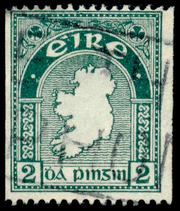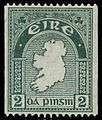1935 Irish 2d coil stamp
| The Rare 2d Coil Twopence coil stamp | |
|---|---|
 | |
| Country of production | Ireland |
| Location of production | Dublin |
| Date of production | 1935 |
| Nature of rarity | Few printed |
| Number in existence |
20 mint, several used, a few on cover |
| Face value | 2d |
| Estimated value |
GB £9,000 (mint)[1] GB £1,500 (used)[1] |
The Rare 2d Coil was an experimental vertical coil stamp, denominated 2d, issued by the Irish Post Office in 1935[2][3] and is one of the scarcest, and most valuable, Irish stamps. It is often referred to by stamp collectors simply as "Scott 68b" or "SG 74b",[1] being the Scott and Stanley Gibbons stamp catalogue numbers respectively.
Design
Philatelists refer to the configuration as '"perf 15 x imperf",[4] or in the USA as "perf 15 horizontal", because the stamp is perforated 15 gauge (holes per 2 cm) on the horizontal and imperforate on the vertical edges. Because of the shared design it appears identical to the first 2d value definitive stamp issued on 6 December 1922 with the Map of Ireland except for the imperforate vertical edges.[1] It uses the first Irish watermark that was a stylised design of the two overlapping letters 's' and 'e' making an 'se' watermark representing the name of the country Saorstát Éireann (Irish Free State).[1][5]
History
It was first recognised in 1937[4] but not acknowledged by the philatelic catalogues until Scott listed it in 1952. Over the years 20 copies have been identified in mint condition,[6] but the quantity used is not known however, even though several have been recorded, they are scarce.[7] A few copies are known on cover but Dulin suggests that all Irish coil stamps are scarce on cover.[8] Some debate as to the genuineness of this stamp took place in the Irish philatelic literature during the mid-1990s with a suggestion the stamp had been fabricated from a normal fully perforated stamp with a press. This hypothesis was debunked by Foley and Ian Whyte, a Dublin stamp dealer, who both claimed such a process would damage the stamp and be scientifically impossible. Archived documents were also found that confirm the stamp were ordered and issued by the Irish postal administration.[9][10]
-

2d Map of Ireland stamp perforated on all sides from a regular sheet of stamps; 1st letter rate stamp
-

Mint 68b that received a Philatelic Foundation Certificate in 2010 was sold in an April 2011 Kelleher auction for $12,500.00 (plus 15% buyer fee)[1]
- ^ "Sale 624 Lot 3305". Kelleher Auctions. 10 April 2011. Retrieved 2 May 2011.
Forgery
In 2004 a forgery of this stamp was reported in The Revealer, the journal of the Éire Philatelic Association, that had been found in the "Maryland forgeries" and offered for sale by a noted collector Roger West of Phoenix International. The forgery is paler than the genuine stamp and the print is coarser, on a white ungummed paper and perforated 10.75 x imperf. The printed stamp area is 18.0mm x 22.5mm compared to 18.5mm x 22.0mm on the original.[11]
See also
References and sources
- Notes
- 1 2 3 4 5 Stanley Gibbons (2004), p. 1
- ↑ Foley (1995), p.31
- ↑ While Stanley Gibbons refers to this stamp as being issued in 1934 in their catalogue, Foley illustrates archived official correspondence dated 1956 between Stanley Gibbons and the Department of Posts and Telegraphs that confirms 1935 as the year of issuance.
- 1 2 Bugg (1996), p. 15: Bugg improperly identifies the stamp as perf 14 x imperf
- ↑ "The First Definitive Series of the Irish Free State and Irish Republic, 1922–1968". Arwel Parry. Archived from the original on 5 January 2008. Retrieved 10 May 2008.
- ↑ Foley (1995), pp. 65–69
- ↑ Feldman (1968), p. 76.
- ↑ Dulin, Cyril (Winter 1993). "Coils on Cover". The Revealer. USA: Éire Philatelic Association. 43 (3): 52–53. ISSN 0484-6125.
- ↑ Foley, Joe (Winter 1994). "The 2d Coil Stamp (SG74a, Scott 68b), A Friendly Rebuttal". The Revealer. USA: Éire Philatelic Association. 44 (3): 47 & 57. ISSN 0484-6125.
- ↑ Whyte, Ian (Winter 1994). "The 1935 2d Coil Stamp (SG74a, Scott 68b),". The Revealer. USA: Éire Philatelic Association. 44 (3): 47–48. ISSN 0484-6125.
- ↑ Foley, Joe (Fall 2004). "The Rare 1934 2d Coil Stamp—Forgery". The Revealer. USA: Éire Philatelic Association. 54 (2): 20. ISSN 0484-6125.
- Sources
- Bugg, Peter E. (1996). The First 55 Years of Irish Coils. Éire Philatelic Association, USA.
- Feldman, David (1968). Handbook of Irish Philately. Dublin, Ireland: David Feldman Ltd & the Dolman Press Ltd.
- Foley, Joseph E. (1995). The Rare Coil. Joseph E. Foley, USA. (Past-President American Philatelic Society )
- Stanley Gibbons (2004). Stanley Gibbons Stamp Catalogue: Ireland, 2nd Edition. London: Stanley Gibbons Ltd. ISBN 0-85259-583-2.